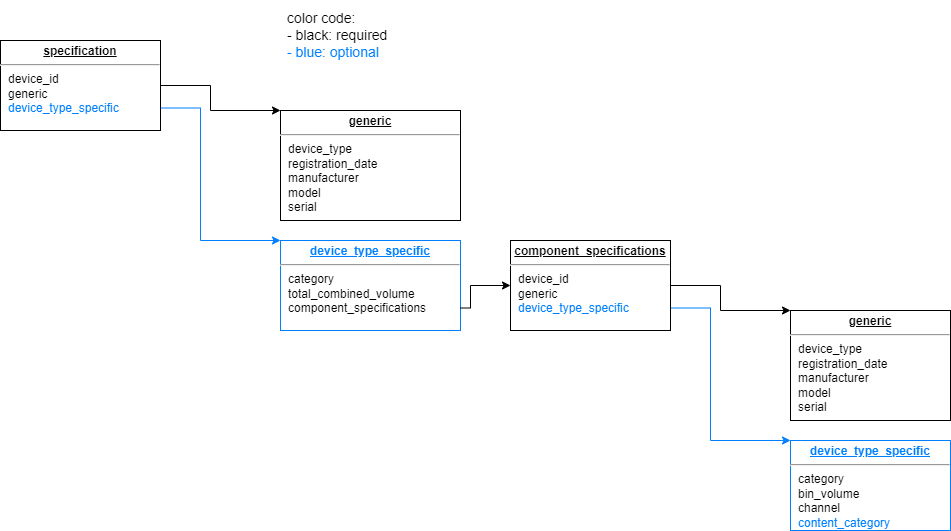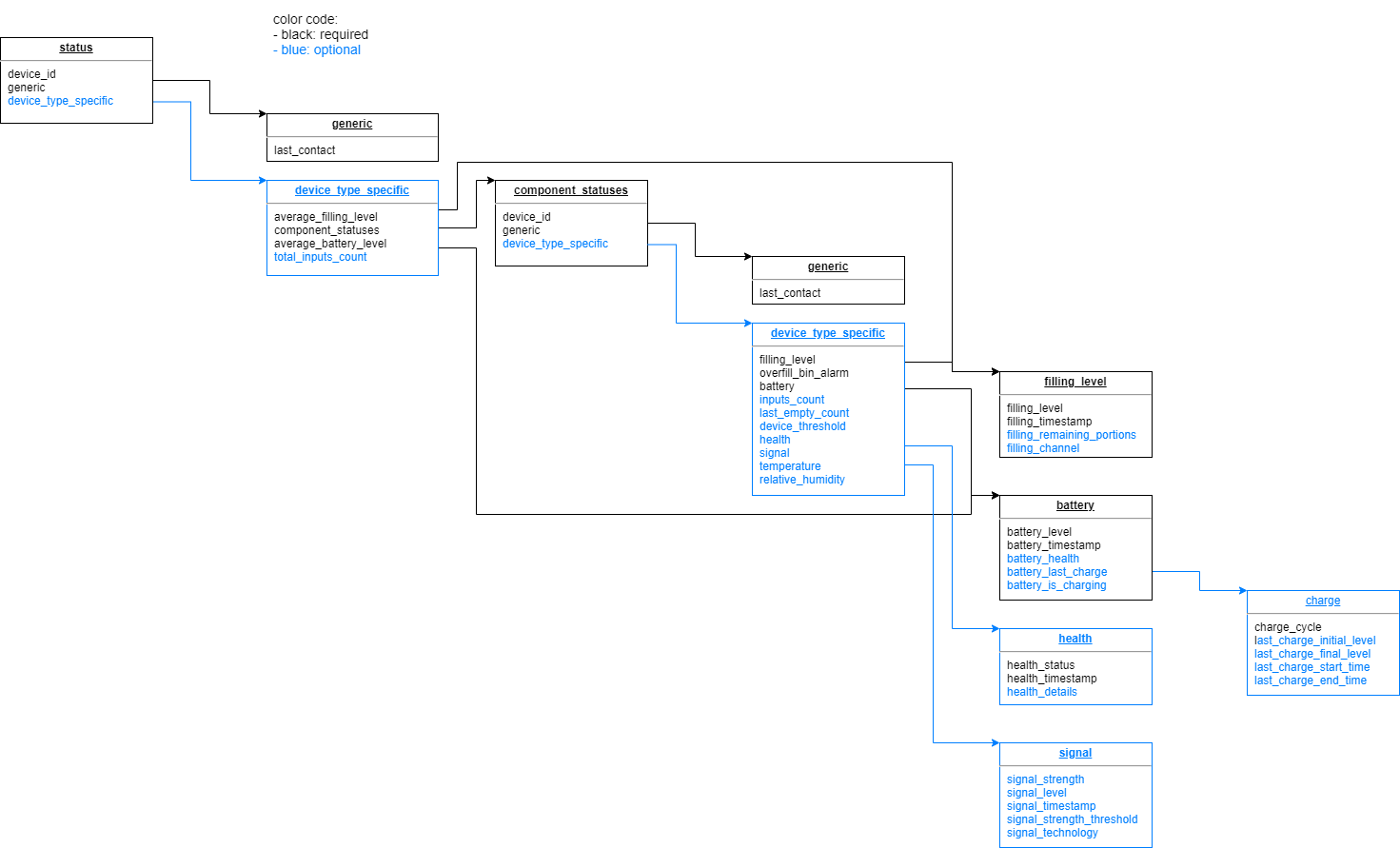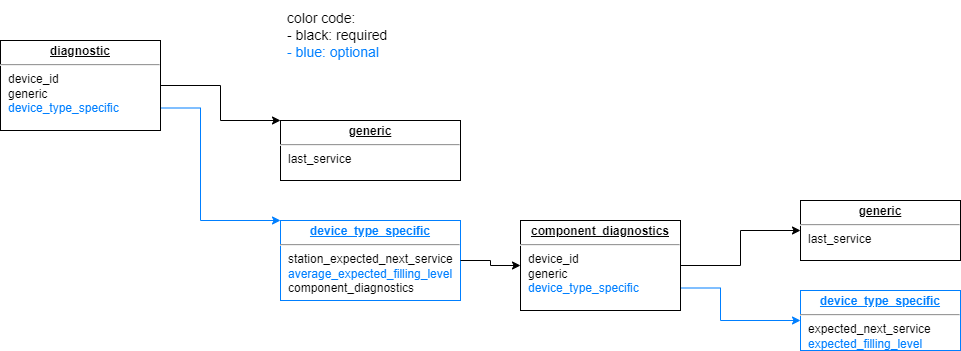3.6. Waste station
A Waste Station is a stationary combination of multiple bins in one unit for collecting and separating different types of waste. For this purpose, a Waste Station consists of an amount of bins. Each bin can be color marked. A Waste Station is a device with one integrated sensor per bin to detect number of usage, filling level, and other data. Each sensor communicates with a server to send real-time raw data. The server collects, aggregates, analyzes and interprets this raw data and outputs detailed reports.
3.6.1. Definitions
- Total combined volume
- The sum of the individual bin volumes in liters
70l 110l
- Component specifications
A list of bin specifications for each individual bin/ container
- Average filling level
- Average filling level of the single bin in percentage
78%, 100%, 0%
- Average battery level
- Average battery level of the single bin in percentage
100%, 50%, 0%, …
- Total input count
- The total of the waste input in the waste station
1002 times
- Component statuses
A list of bin statuses for each individual bin/ container
- Station expected next service
- The date when the complete waste station must be emptied
24.01.2020 15.27
- Average expected filling level
- The expected average filling level when the waste station must be emptied
98%, 100%
- Component diagnostics:
A list of bin diagnostics for each individual bin/ container
3.6.2. FDS compliance requirements
3.6.2.1. Object model
3.6.2.1.1. Specification object for the waste station device type
the device information provider must provide a specification object that contains a device_type_specific object defined in the following diagram

The channel element must be one of
“left”
“middle_left”
“middle_right”
“right”
“total”
When provided, the content_category element can be one of
“residual waste”
“paper waste”
“plastic waste”
“bio waste”
3.6.2.1.2. Status object for the waste station device type
the device information provider must provide a status object that contains a device_type_specific object defined in the following diagram

When provided, the channel element, in the filling_level object, must be one of
“left”
“middle_left”
“middle_right”
“right”
“total”
3.6.2.1.3. Statistic object for the waste station device type
Note
The Statistic object is not being defined for waste stations in FDS Version 2
3.6.2.1.4. Diagnostic object for the waste station device type
the device information provider must provide a status object that contains a device_type_specific object defined in the following diagram

3.6.2.2. Web API (Pull Model)
The device information provider must expose the specifications endpoint to get the list of available devices and their specifications
GET https://{Device Information Provider URL}/fds/v2/specifications
The device information provider must expose the statuses endpoint to get the latest status for one or multiple devices
GET https://{Device Information Provider URL}/fds/v2/statuses
Note
the statistics endpoint to expose the statistic information is not being defined for waste stations in FDS Version 2
A call to:
GET https://{Device Information Provider URL}/fds/v2/statistics
must return an error object
{
"status": 204,
"message": "not_implemented"
}
The device information provider must expose the diagnostics endpoint to get the diagnostics object for one or multiple devices
GET https://{Device Information Provider URL}/fds/v2/diagnostics
The device information provider must expose the POST request on the tag endpoint to let a client application create a new tag
POST https://{Entity Information Provider URL}/fds/v2/tag
The device information provider must expose the GET request on the tag endpoint to provide the content of a tag
GET https://{Entity Information Provider URL}/fds/v2/tag
The device information provider must expose the DELETE request on the tag endpoint
DELETE https://{Entity Information Provider URL}/fds/v2/tag/<tag_id>
The device information provider must expose the PUT request on the tag/<tag_id>/entities endpoint
PUT https://{Entity Information Provider URL}/fds/v2/tag/<tag_id>/entities
The device information provider must expose the DELETE request on the tag/<tag_id>/entities endpoint
DELETE https://{Entity Information Provider URL}/fds/v2/tag/<tag_id>/entities
3.6.2.3. Publish/Subscribe (Push model)
3.6.2.3.1. Events
The device information provider must publish the following alerts and notifications
Message code |
Description |
Message category |
Message code specific object |
|---|---|---|---|
offline |
The device is not communicating |
notification |
last_contact |
bin_overflow |
The bin filling level is more than 100% |
Alert |
None |
mold_detected |
The device detected mold |
Alert |
None |
3.6.2.3.2. Publish status information
The following data must be published by the manufacturer
- fds/v2/<subscriber_id>/<tag_id>/waste_station/<device_id>/status/average_filling_level
- payload:
average_filling_level
3.6.2.3.3. Publish diagnostics information
The following data must be published by the manufacturer
- fds/v2/<subscriber_id>/<tag_id>/waste_station/<device_id>/diagnostics/last_service
- payload:
last_service
- fds/v2/<subscriber_id>/<tag_id>/waste_station/<device_id>/diagnostics/station_expected_next_service
- payload:
station_expected_next_service